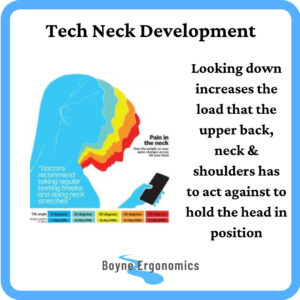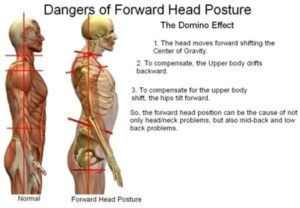The inspiration for this blog post came to me last week. I was standing at the bus stop waiting for the school bus. Heavy traffic meant the bus was much later than usual and so I was still there when the local secondary school finished for the day. As groups of teenagers joined me at the stop I noticed a common posture – neck flexed, head down, phone in hand. I am not talking a light nod of the head here; the chins were nearly touching the chests!
It took all my restraint to stop myself going around them all to raise their heads and their phones. I could feel the strain of the neck tissues.
This got me thinking about Tech Neck and the potential impact of prolonged and frequent poor neck posture on future adults.
In this post, I will define what we mean by the term “Tech Neck”, what the causes and symptoms are, what the potential effects could be, how to assess if you have Tech Neck and what you can do to prevent or treat it.
What is “Tech Neck”?
Tech Neck, Text Neck or Forward Head Syndrome are all terms used to describe pain and discomfort associated with repetitive strain & injury to the structures & tissues of the neck.
The cervical spine, also known as the neck, refers to the top seven vertebrae of the spine and it is flexible to allow for the movement of the head. It also should have an inward lordotic curve to balance out the curve of the thoracic spine and the weight of the skull.

The average head weighs approximately 5Kg. When you are upright, with your head balanced on top of your spine, the neck, shoulders and upper back can easily support this load and regular head movements as that is what they are made to do.
As you start to flex the neck and look downwards, the force of gravity acting on the head increases the load that the neck, shoulders and upper back have to support. This load increases the further down you look and at 60o flexion, the load has been found to increase to 27Kg!

I should say that looking down and neck flexion, in general, are not bad. Our cervical spine has evolved to allow the head to move in the direction we need it to, including looking down. However, the longer and more often you look down, the harder the muscles and tissues have to work to support your head, the more you compress the discs in the cervical spine, restrict blood flow and the more the tendons and ligaments have to stretch.
Why Is “Tech Neck” An Issue?
Neck flexion and downward head postures are not new to modern times. People have always had jobs, tasks or hobbies that require them to look down at a surface and their hands. However, what has changed over time is the duration and frequency of these postures.
The increase in tele-working (e.g remote working, agile working, home working, hybrid working etc) has led to an increase in the use of mobile technologies. The ease of use and flexibility of work location that these devices provide have revolutionised the way we work and communicate. Mobile device use has also increased, both for educational and recreational purposes, meaning that these adverse head and neck postures can be present during both work and leisure tasks.
Holding adverse neck and head postures for prolonged periods and repetitive movements between mobile devices can increase the risk of abnormal wear and tear of the cervical discs, reduced blood flow, strain of the tendons and ligaments and inflammation and fatigue of the shoulder, neck and upper back muscles.
If these adverse postures become prevalent, it can cause the development of cervical kyphosis, the exaggerated forward curve of the vertebrae of the neck, along with weakened chest muscles and elongated upper back muscles.
Children and young adults are, I feel, at an even greater risk of long-term issues associated with adverse neck postures. As smartphone, tablet and hand-held console use among children and teenagers increase, so too does the potential for prolonged adverse neck postures associated with using these devices. Prolonged adverse neck postures while the musculoskeletal system is still developing has to impact spinal alignment and musculature, meaning that many young people may potentially be reaching adulthood with a compromised spinal structure.
What are the Symptoms of Tech Neck?
Generally, like a lot of cumulative musculoskeletal disorders, the symptoms start as mild niggles and increases in severity over time. The most common symptoms are:
Stiffness and an aching discomfort in the neck, shoulders and upper back
Headaches
Decreased range of movement in the neck
Intense stabbing pain in the neck or shoulder
Pain in neck when looking down
Jaw pain
Tingling and numbness in the arm or hands
What are the Long Term Effects of Tech Neck?
As with all musculoskeletal issues, ignoring the minor discomfort and niggles can lead to longer term consequences. These include:
Difficulty maintaining appropriate neck posture (ear over shoulder) when not looking at mobile devices due to weakening of muscles across the chest and elongation of the muscles of the upper back.
Abnormal wear and tear to the cervical vertebrae.
Damage to the cervical discs resulting in disc bulges, ruptures or herniations. This can affect the strength and mobility of the arms and hands.
Abnormal curvature of the cervical spine, cervical kyphosis, leading to a hunched upper back posture, with the head pushed forward away from the neck.
Pain in the mid and lower back caused by changes in posture to compensate for the forward head positioning.

Do You Have Tech Neck?
Below is a quick posture test you can do to check if you currently have Tech Neck, or Forward Head Posture.

Posture Test for Tech Neck / Forward Head Posture
How to Treat and Prevent Tech Neck
If you work at a computer, ensure all monitors are positioned correctly, including laptops and tablets. Use laptop and tablet stands to raise them to an appropriate level.
Use external keyboard and mouse with tablets and laptops to allow for appropriate screen positioning.
When seated or standing, be upright with shoulders relaxed, chin up and head balanced on top of the spine. Your ear, shoulder and hip should be aligned. Check your posture in the mirror during the day.
When using the mobile phone, bring the phone up towards eye level as opposed to bending your head down to the level of the phone. If you are at the desk, use a height adjustable phone stand so you are not repetitively moving the head up and down between monitors and phone.
Take breaks! Any static postures increase the risk of musculoskeletal strain, more so when the posture being held is outside of the neutral range. Put the phone / tablet down, leave the chair and walk around even for a minute every 20 minutes (45 minutes if working at the desk with the phone / tablet / laptop elevated) to allow the muscles and tissues to relax.
Use exercise and stretching to strengthen and release tension in the muscles of the back neck and shoulders. Walking, jogging, swimming, cross trainer, Pilates and Yoga can all help release tension, strengthen the muscles and improve posture.
Regular stretches and gentle movements of the neck, shoulders and arms during the day can also help reduce symptoms.
Seek professional medical help if the symptoms are worsening, preventing you from sleeping and affecting your day-to-day activities.
If you have children or young people using devices for educational or leisure purposes, encourage safe postural habits. Use tablet holders, laptop stands, additional cushioning etc to elevate the height of the screen. Use timers to limit the length of continuous time on the devices. Encourage participation in sport, exercise or physical play to encourage healthy musculoskeletal development.


In reality, we do not, and never have, gone about our daily tasks with our heads perfectly balanced on top of our spines at all times. It would be impractical and unsafe! Our cervical spine is designed to allow a high level of head movement and so the issue is not with the action of looking down. The concern is the increase in static and repetitive adverse neck postures and the cumulative time spent with the head looking down at mobile devices and the subsequent effect this is having on musculoskeletal health.


